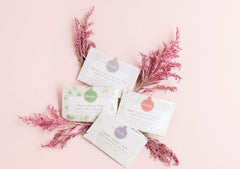Toxic. Shock.
Both words have such a spine-chilling sound, no wonder most of us have feared this dangerous condition since we first started our periods! Most moms, wanting to keep us as safe as possible, made sure we never forgot about this unlikely-but-oh-so-possible byproduct of using tampons and period care products.
But how common is it? Is it something that just women on their periods can get? And what are the TSS symptoms that you need to know?
We’re going to go through all the ins and outs of this bacterial infection and try to answer all the questions you have!

What is TSS (Toxic Shock Syndrome)?
Most of us can spout off that TSS is an awful side effect of leaving old blood inside you for too long. You’re never supposed to keep a tampon in longer than 12 hours (best to leave it for 4-8) and if you do, you should be on edge, looking for fever, chills, and nausea. Check.
But here are some facts that should empower you with knowledge and help to alleviate your worries!
TSS is a bacterial infection that causes vital organs to begin to shut down but can be treated with medication in the hospital. This infection is mainly caused by Staphylococcus aureus, Streptococcus pyogenes, and Clostridium sordellii. (1)

TSS isn’t just something women get. So what causes toxic shock syndrome? It’s an infection that can appear in men, women, and children after experiencing a viral infection, surgery, or infected wounds or by using any vaginal devices, including tampons, menstrual cups, or sponges. (2)
Most of us will never know someone with TSS because it is incredibly rare. TSS, on average, affects 1 in 100,000 menstruating women (and 3-6 people per 100,000 per year). Cue that deep sigh of relief! (3)
While staph lives on one third to one half of the population, about 80% of the population has antibodies to S. aureus, protecting them from developing TSS. (4)
What Causes You to Develop Toxic Shock Syndrome?
To develop TSS, you must have four things in play —
- Staph bacteria existing in the vaginal canal, which we’ve already discovered is rare.
- The pH balance must be closer to neutral, which does naturally happen during menstruation. But thankfully, our bodies are designed to fight pathogens!
- For bacteria to grow, it needs oxygen. Inserting tampons and menstrual cups do introduce oxygen, but unless you have staph, it’s harmless.
- The last necessary factor is entering the bloodstream. You need to have a cut, sore, or tear that moves the infection into your body.
While TSS is incredibly rare, you should always wash your hands before touching your vaginal area, practice good hygiene, and use products that have fewer chemicals, which have less chance of causing TSS.

What are the TSS Symptoms?
It’s a fast-developing infection. You need to watch out for these symptoms of toxic shock syndrome —
- Fever
- Rash that looks like a sunburn
- Vomiting or diarrhea
- Peeling skin on the feet and hands
- Headaches, joint pain, and muscle aches
- A sore throat
- Red eyes or sensitivity to light
- Blood pressure drop
- Kidney failure
Typically, we all tend to minimize our symptoms until they’ve started to get worse.
TSS is a rare illness, but if you have used an internal period care solution and have some of these symptoms, you should call your doctor or go to a local urgent care center right away. To treat this infection, doctors will provide antibiotics; and if a person is severely ill, they would need intensive care support for life threatening illness.
Is it Possible to Get TSS More Than Once?
Those who have experienced TSS are at risk for the infection a second time and maybe advised to stay away from tampon or cup use.
So, How Do I Protect Myself from TSS?
To protect yourself, we would recommend two things —
- Be incredibly intentional with your hand hygiene.
- Clean your period care device appropriately every time you use it!
Here are some other common questions and helpful tips on all period care options.
What is the safest period care option?
The safest way to deal with your period is by using pads or period underwear. Our cloth pads have an antimicrobial charcoal layer that helps to minimize any bacteria near your vagina. If you’re wondering, “Can you get TSS from pads?” the quick answer is — yes. If you have all the right conditions for developing TSS in your vagina, you can develop it. But it is most unlikely with our anti-microbial pads.

How long can you keep a tampon in?
If you’re using a disposable tampon, be sure to remove it every 4-6 hours and not leave it in for more than 12. Most experts recommend never using a high absorbency tampon — and because all tampons contain chemical byproducts and can cause abrasions in your delicate area, we recommend avoiding tampons altogether.
Can you get TSS from period cups or sponges?
There are some great ways to keep yourself safe while using a period cup or sponge. We’ll say it again — the best piece of advice is to be meticulous with your cleaning regimen! But we do recommend avoiding internal period care options if you have a vaginal cut, tear, or sore or are dealing with any vaginal infection.

To avoid bacteria growing on your sea sponge —
- Never use harsh soaps or chemicals to wash the sponge or cup. They can leave chemicals that upset the pH level. A mild, fragrance-free, non-oil-based cleanser is the best option for cleaning your period care.
- Don’t boil your sponge. This can cause sponges to shrink or become more brittle.
- Only soak your sponge for 10 minutes at a time, either using a 1 (water) :10 (vinegar) mixture or 1 cup of water mixed with 1 tbsp of baking soda.
- Always let it dry completely before storing.
For your period cup, you should —
- Boil your cup before first use and between uses for 4-5 minutes. (But don't boil it often. It can lead to the cup breaking down.) You can also wipe with 70% isopropyl alcohol to sanitize between uses. And simply wash your storage bag in the laundry.
- Rinse your cup with cold water and a mild, fragrance-free, non-oil-based soap between each use.
- Wash your hands well before inserting or removing your period cup.
At Femallay, we provide the most natural feminine wellness solutions that are good for you and good for the planet. Check out all of our products to help you live a healthier and happier life every day of the month! If you have any other questions on TSS symptoms or period care options, please reach out to us at hello@femallay.com!
- https://www.hopkinsmedicine.org/health/conditions-and-diseases/toxic-shock-syndrome-tss
- https://www.mayoclinic.org/diseases-conditions/toxic-shock-syndrome/symptoms-causes/syc-20355384
- https://healthcare.utah.edu/healthfeed/postings/2018/07/tss.php
- https://www.ncbi.nlm.nih.gov/pmc/articles/PMC1234102/








